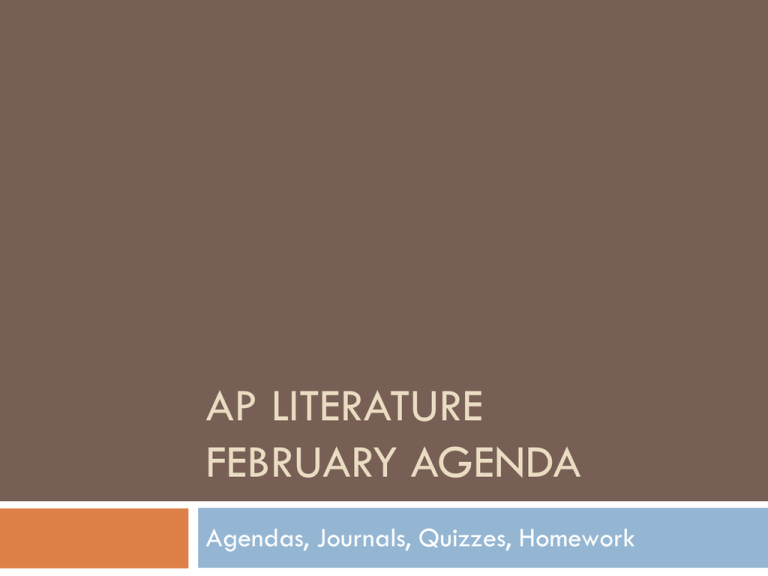AP Literature February Agenda
advertisement

AP LITERATURE FEBRUARY AGENDA Agendas, Journals, Quizzes, Homework Agenda 2/5/13 C & P Snippet Activity-Part V &VI Part V & VI Socratic Seminar: 30-40 minutes After lunch: Turn in close reading assignment for John Donne passage Multiple Choice: 12 minutes Ethan Frome-Edith Warton by Monday, Feb.11th Snippet Activity-Quiz grade Select one snippet from Part V and one from Part VI. Choose a small bit of text—a snippet (perhaps a word, phrase, possibly a sentence—at a stretch two sentences if they are not long) It strikes you Puzzles, perplexes, delight, anger you w/its controversy, truth, irony, rightness, weirdness, humor, etc. Reveals character, suggests mood or atmosphere, exemplifies tone and/or theme, is part of a pattern you noticed In a couple of sentences, give context to the snippet Tell why you chose that particular bit of text Agenda 2/7/13 Major Works Data Sheet-C&P due Independent Novel Choice Writing Examples-What do you think? Self evaluation of Centaur/Street essays Tracking M/C Prose passage #4-What types of questions did you miss? Make sure to give me your choice before you leave today! Tracking Reminder: You need Ethan Frome for Monday, 2/11 Mock Exam Prose Prompt Q2 Read the following passage carefully. Then write an essay analyzing how the author characterizes Sylvia and her relation to the natural world. Using evidence from the text discuss Sylvia’s discovery of the “vast and awesome world.” Example #1 Sylvia has a lot in common with the natural world She started with a belief “that whoever climbed to the top of it could see the ocean.” (Line 6-7) It meaning a large mountinous white oak tree. Her first obstacle in her adventure in the natural world was to climb the ginormous tree. To see “the sea with the dawning sun making a golden dazzle over it.” (line 39) Proving what she had thought since a child created an imaginative way of thinking. At the top of the tree “Sylvia felt as if she too could go flying away among the clouds.” (line 42-43) Sylvia had seen a winged majestic animals with its slow moving pinions over the sea. The winged animals were two hawks “ their gray feathers were as soft as moths.”(line 41-42) Example #2 The essays gives a vast description of the surrounding world and how Sylvia interacts with it. Sylvia discovers the woods by exploring and adventuring through them. The imagery that is used creates this idea of her being connected with the tress when she climbs them. “Sylvia felt her way easily” shows her comfort around the environment and the ease she has while there. But she is also characterized by her innocence of her going out and exploring by herself. She is described with a “childish heart” that has great ambition to climb the tree to see the ocean. The relation she has with the natural world is unique. Here she can be free and explore without any worries. She is comfortable there “Sylvia knew it well” knowing that the natural world is a place she can go to be a kid and keep her youth and innocence but also being independent. Example #3 The natural world is a vast, expansive wonder that is free for all to see. In this passage, Sylvia is discovering how amazing nature can be. Its inconceivable beauty and size is developed in Sylvia’s mind. Her relationship with nature is a familiar, but still wondrous mentality. Sylvia’s comfortable relationship with nature is depicted in the passage by creating an expansive, beautiful world. Sylvia’s character is developed as a child with curiosity about the life around her, who is already “at home” when she is in the wilderness. The comparison of her climbing the tree to “fingers that pinched and held like bird’s claws” (line 14) gives the reader the idea that Sylvia is so comfortable in nature that she has become animal-like. Although she is just a child, it is apparent that she has been practicing these skills for quite some time. Her belonging in the natural world is depicted when the author personifies the tree as “amazed…as it felt this determined spark of human spirit”climbing up its great branches. The fact that even the wildlife respected her presence is very powerful. Example #4 Sylvia’s characterization and relation to the natural world is described through the author’s switching of roles. Usually humans are the dominant force while everything around them is simply trivial matter. However, in this passage the author seems to make Sylvia a determined, but naïve girl in the powerful and captivating world around her. The author contrasted Sylvia’s physical attributes with her internal drives. The description of “small and silly Sylvia” is reimbursed with her “spirit of adventure,” “wild ambition,” “fancied triumph,” and “delight and glory.” The author also contrasts Sylvia’s inquisitive nature with the inactive and calming role of the natural world. He personifies the tree as being “asleep” and describes the moonlight as being “pale” while simultaneously depicting Sylvia as an active force with “tingling, eager blood.” Sylvia’s determination is also evident when the author describes her as “almost lost,” but then suddenly painting an image of how she “felt her way easily.” Her(Sylvia’s) determination as well as the world’s powerful presence is reiterated in the third paragraph, when nature is now being personified. The author depicted nature as a harsh character that “caught and held her and scratched her like angry talons.” However, the world isn’t acting as an antagonist for Sylvia, but merely a test of her devotion to adventure and enlightenment. Self-Evaluation of Essays For each essay (The Street and The Centaur) do the following things: Highlight your thesis statement Highlight every piece of textual evidence that supports your thesis Highlight (different color) commentary/analysis Using the rubric, score your essay Complete a tracking entry for each essay








